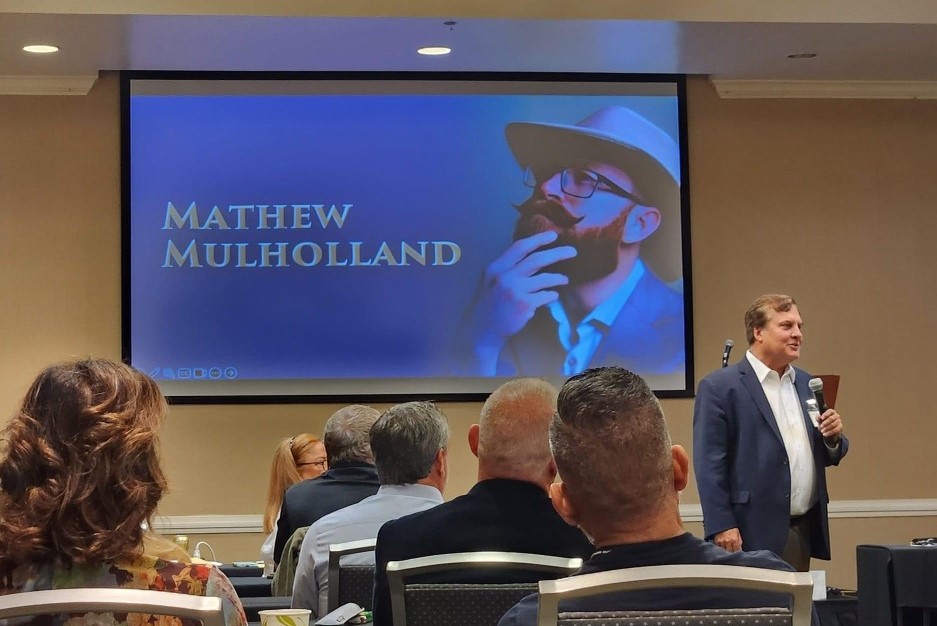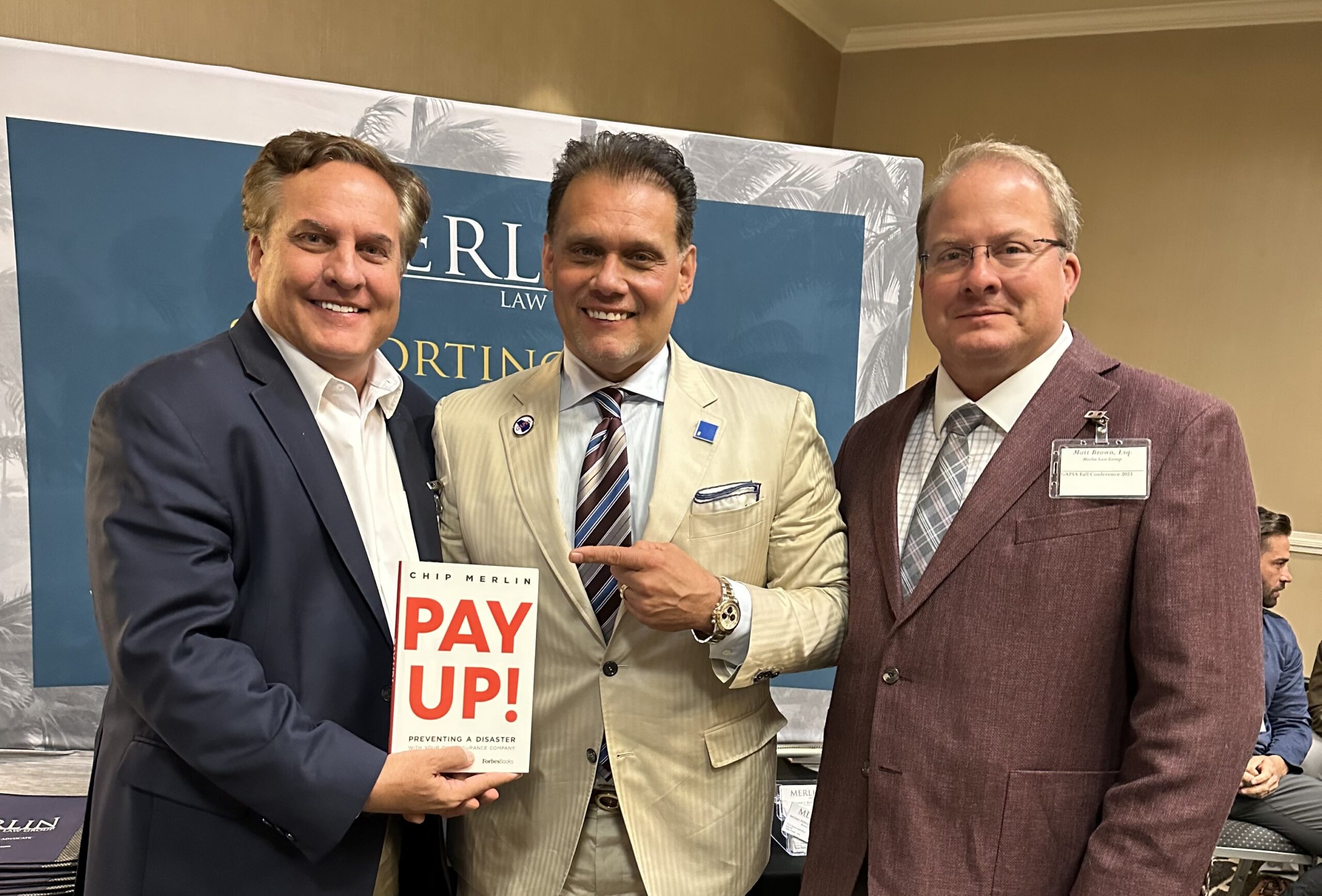The above picture was taken by “One T” while I was presenting my speech on “Would You Hire You?” I was congratulating him for becoming an excellent insurance educator for public adjusters. He humbly seemed surprised that I would single him out.
There were three aspects of his education sessions, which I think made them unique. First, he used actual denials by insurance companies and reports from their outcome-oriented engineers to show how the insurance industry was straining the meaning of the wear and tear exclusion. Second, he developed his own flow chart for how to interpret the wear and tear exclusion in the context of Georgia’s efficient proximate cause doctrine. Finally, he encouraged participation with questions and thought provoking answers that had me engaged and thinking deeply and re-reading policy language, Georgia case law, and even insurance company websites, which explained how they explain the wear and tear exclusion.
Georgia follows the efficient proximate cause doctrine. Some insurance companies and their lawyers will try to use the doctrine to argue anything to avoid paying a claim. One case involved a situation where the insurer argued that the covered flood damage was excluded because rain and snow caused the flood.1 The court would have none of this crazy interpretation, ruling:
As explained, Plaintiff says the trailers were damaged when the Umatilla River overflowed its banks, a covered loss under the definition of ‘Flood.’ Defendant acknowledges the damage to the travel trailers was caused by the Umatilla River ‘overflow[ing] its riverbanks.’ Defendant, however, contends that the river did this because of rain and snow, thus precluding coverage under the rain and snow exclusion. Plaintiff contends this interpretation is unreasonable given the flood coverage provided by the Policy and the lack of any reference to flood in the rain and snow exclusion. Plaintiff claims the more reasonable interpretation is that the rain and snow exclusion applies to property left outside and damaged by the elements, such as falling rain and snow. It argues, if Defendant wished to take flood coverage away by the subject exclusion, it would have specifically referenced damage caused by floods.
The Court concludes the language is unambiguous and provides coverage for the damage caused by the flooding of the Umatilla River. The Policy defines ‘Flood’ (a covered loss) to include the ‘overflow of a body of water [ ] whether caused by wind or not.’ The Umatilla River is a body of water. It overflowed, that is, left its banks and flooded Plaintiff’s location. By its clear terms, the policy covered damage caused by the river exceeding its banks and damaging Plaintiff’s property. The exclusion Defendant relies upon refers to damage to property ‘in the open caused by rain, snow, ice or sleet.’ The inclusion of the words ‘in the open’ was clearly meant to exclude losses due to rain, snow, ice, or sleet that fell from the sky onto Plaintiff’s personal property, thereby damaging it. That is its plain meaning. Otherwise, why identify the property as that ‘in the open.’ It was not intended to exclude damages for rain that fell— not on property left in the open—somewhere else, flowed across some other land into the river, combined with rain from all over the place, and caused the river to overflow. Rivers carry water. Most (or perhaps all) of that water comes from rain and snow. To say that damage from an overflowing river is excluded if that body of water contains rain water would completely due away with the flood coverage. And finally, the definition of ‘Flood’ states that it includes the overflowing of a body or water ‘whether driven by wind or not.’ That means whether the overflow is caused by wind or another cause. It does not exclude overflows caused by rain. The Court concludes the plain language of the term ‘Flood’ includes the overflowing of a river as a result of rain. Defendant’s tortured reading of the rain and snow exclusion is inconsistent with that provision’s plain meaning.
The court then explained how the efficient proximate cause doctrine applies in Georgia and why the insurance company was again wrong in its interpretation of this doctrine:
‘The efficient proximate cause doctrine applies when two or more identifiable causes contribute to a single property loss-at least one of them covered under the policy and at least one of them excluded under the policy.’ Burgess v. Allstate Ins. Co., 334 F. Supp. 2d 1351, 1260 (N.D. Ga. 2003).
The doctrine of efficient proximate cause governs situations where a risk specifically insured against sets other causes in motion in an unbroken sequence between the insured risk and the ultimate loss. In such situations, the insured risk is regarded as the proximate cause of the entire loss, even if the last step in the chain of causation was an excepted risk. When an insured can identify an insured peril as the proximate cause, then there is coverage even if subsequent events are specifically excluded from coverage.
Under an efficient proximate cause analysis, the question becomes whether a covered event is the efficient and proximate cause of the plaintiff’s loss even though an excluded event contributed to the loss as well….
As explained above, the Court concludes the excluded event (rain or snow falling on property left in the open) is not the cause of the loss at issue. The proximate cause (indeed sole proximate cause) was the overflow of the Umatilla River and that was a covered event. This is not a situation in which two events—one covered and one not covered—caused the loss. The efficient proximate cause doctrine is thus inapplicable. And, as also explained above, to the extent this language is in any way ambiguous, the Court will strictly construe it against Defendant….That would lead to the same outcome, a determination the rain and snow provision does not exclude a flood caused by rain and snow falling other than on personal property left in the open. So again, the efficient proximate cause doctrine does not apply.
Those clever insurance company attorneys should go to one of Mathew “One T” Mulholland’s seminars. They will learn a thing or two about how to interpret insurance coverage. I certainly did.
Thought For The Day
Great things are done by a series of small things brought together.
—Vincent Van Gogh




